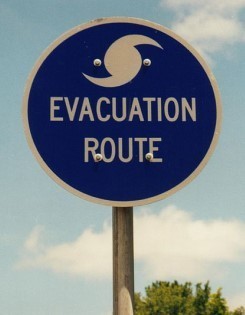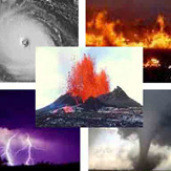
Evacuations are quite common and happen for a number of reasons – fires, floods, mudflows, hurricanes, tsunamis, or chemical spills on the roads or railways.
When community evacuations become necessary, local officials provide information to the public usually through the media. Government agencies, the Red Cross, churches and other relief organizations provide emergency shelter and supplies. But you should have enough food, water, clothing and emergency supplies for days or weeks (or more) in case you cannot be reached by relief efforts.
The amount of time to evacuate obviously depends on the type of disaster. Hurricanes can be tracked and allow a day or two notice to get ready, but many types of disasters happen without much notice… so prepare NOW!!
BEFORE AN EVACUATION:
Ask & learn - Ask emergency management officials about community evacuation plans and learn the routes that should be used. Also learn the signs used for your area - and, if you’re traveling, make a mental note what evacuation signs look like in case something happens while on the road. And ask if your local officials have developed pet-friendly shelters and pet-related disaster plans through the 2006 PETS Act.
Make a plan - Develop a Family Emergency Plan (so you know where to meet if separated, how to contact everyone, have a Disaster Supplies Kit or Bug Out Bag ready to go, etc.) If you don’t have a car, make arrangements with friends, neighbors or local officials so you have a way to evacuate.
Think about your pets - Make a plan for your critters and pack supplies for them in your Disaster Supplies Kit. Remember, emergency shelters may not accept pets (unless it is a service animal) so find out which motels and hotels allow pets in advance of needing them. Ask your veterinarian or animal shelter if they board animals during a disaster or emergency. Also make sure identification tags are current and securely fastened to pet’s collar or get a microchip implanted in your pet. Keep a current photo in your wallet or cell phone for identification purposes. And make sure a roommate, trusted neighbor or friend has an extra house key to evacuate your pets in the event you are unavailable.
Large animals - Make arrangements for evacuation, including routes and host sites, in advance. At least two alternate evacuation routes should be mapped out as a backup. The evacuation site should have food, water, veterinary care, handlers, equipment and proper facilities.
Where do we go? - Talk with your family members and decide in advance where you would go in case you can’t return home for weeks or months. If your home is damaged or destroyed or you’re forced to leave your home due to on-going threats (like mudslides or flooding), you will need to find temporary or permanent living quarters. This could mean staying in a public shelter or hotel, living with friends or relatives, or renting a home or apartment in the middle of all the chaos, so discuss several options. Then, write down your various options and share them with relatives and friends.
During a disaster or emergency emergencies, the Red Cross and other organizations set up public shelters in schools, city or county buildings and churches. While they often provide water, food, medicine, and basic sanitary facilities, you should plan to have your own supplies - especially water.
Paperwork & money - Put important paperwork (wills, photo I.D.s, insurance policies, list of bank and credit card numbers, etc.) in a portable fireproof container (and have copies in an off-site safety deposit box) so you have identification to get access to your bank or to set up new accounts if you have to relocate long-term to another town. Also keep copies on a CD, flash drive or external drive and store media in a safe place off-site or in a locked fireproof container. Or consider using a service that allows you to upload scans and securely store your documents on their servers.
Fill ‘er up - Keep car fueled up -- stations may close during an emergency. (Try to stay in the habit of having at least half a tank of gas at all times.)
Learn to shut off - Know where and how to shut off electricity, gas and water at main switches and valves -- ask local utilities for instructions (and keep a wrench handy).
DURING AN EVACUATION:
Listen - Keep up on news reports for the latest information.
Grab & Go - Grab your Disaster Supplies Kit (has water, food, clothing, emergency supplies, insurance and financial records, etc. ready to go).
What do I wear? - Put on protective clothing (long sleeve shirt and pants) and sturdy shoes - may even want to grab a jacket, hat or cap.
Shut off utilities - Turn off main water valve and electricity (if authorities tell you to do so).
Secure home - Close and lock doors and windows, unplug appliances, protect water pipes (if freezing weather), tie down boats, etc. (Certain types of disaster may require different methods of securing home.)
Take quick pics - Use your camera phone to take some shots of your home and property for a last minute inventory of things.
Pets - Make sure you take pets in secure carriers and bring food, water and leashes or harnesses with you. Grab medical records so you can prove immunizations are current. Realize some shelters may not accept pets so have a backup plan on where you’ll go. If you have no alternative but to leave your pet at home, confine it to a safe area inside with dry food and plenty of water. Leave the bathroom door open and toilet lid up (or remove lid completely) so pets can access additional water -- but only if the toilet is free of chemicals. Also, if you must leave your pet outside -- don’t chain it!
Large animals - Hopefully you made arrangements in advance to evacuate livestock and/or large animals. If you must turn them loose, prepare halters for horses that include your name and phone numbers or spray paint your number on the animals and leave lots of food and water out. If there is a wildfire raging, remove nylon halters or synthetic tack from horses so the equipment won’t overheat and potentially burn them.
Alert family & friends - Let others know where you are going (or at least leave a message or note in clear view explaining where you can be found). If pets are left on the property, put a note on door to alert rescue workers.
Social media - Social networking sites allow users to stay current on evacuation and recovery efforts. You may not have access to the Internet during or after a crisis, but text messages can sometimes get through when cell and phone systems are down. The Red Cross, FEMA, local emergency officials and other relief groups use social media to send messages and updates about evacuations and shelter information. Social media sites are also a great way to post photos and videos.
Things to avoid:
- bad weather - leave early enough so you’re not trapped
- shortcuts - may be blocked -- stick to the recommended Evacuation routes
- flooded areas - roadways and bridges may be washed-out
- downed power lines - extremely dangerous esp. in floodwaters
By planning ahead, your family will know where to go and what to do which can help reduce some fear and anxiety that surrounds a disaster.
Above extracted from IT'S A DISASTER! ...and what are YOU gonna do about it? by Bill & Janet Liebsch. Download a free 64-page ebook with more safety and preparedness tips at www.usfra.org/fedhealth


